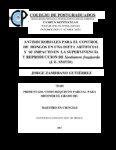| dc.description.abstract | Las dietas artificiales son importantes para establecer crías de insectos bajo condiciones controladas de laboratorio. Sin embargo, en estas condiciones también pueden la contaminación de las dietas con hongos. Para evitar la contaminación de las dietas de insectos se utilizan antimicrobiales que en algunas ocasiones ya están presentes en la dieta o bien se deben agregar a ésta. En el laboratorio de Toxicología de Insecticidas la dieta artificial BioServ Inc., Frenchtown, NJ. se contaminaba con hongos. Así mismo se observó que al controlar la contaminación, ésta se podría utilizar en la cría masiva de Spodoptera frugiperda. El objetivo general del presente trabajo fue estimar la supervivencia, reproducción, duración del ciclo de vida, peso de larvas de tercer instar y pupas de S. frugiperda en la dieta artificial BioServ Inc., Frenchtown, NJ. cuyo desarrollo de hongos se controló con la aplicación de antimicrobiales. Se utilizaron las dietas artificiales Southland Products Inc., Lake Village, AK., la cual ya contiene antimicrobiales y BioServ Inc., Frenchtown, NJ. Ambas dietas se evaluaron con y sin la aplicación de antimicrobiales. Los hongos que contaminaron la dieta artificial BioServ Inc., Frenchtown, NJ. Se identificaron como Penicillium communne, Aspergillus ochraceus, Neurospora tetrasperma, Aspergillus westerdijkiae y Paecilomyces spp. Los antimicrobiales evaluados fueron formaldehido, ácido sórbico, metil paraben, benzoato de sodio, benomil y cloruro de potasio. Los cuales a concentraciones de 0.38, 2.5, 3.0, 2.8, 3.8 y 4.0 %, fueron eficientes para controlar la contaminación. En la dieta BioServ Inc., Frenchtown, NJ. sin antimicrobiales las larvas murieron ya que la dieta se contaminó, mientras que benomil y cloruro de potasio fueron tóxicos para larvas en primeros estadios. Las larvas que se alimentaron de dieta Southland Products Inc., Lake Village, AK. sin antimicrobiales presentaron un mayor ciclo biológico, longevidad de adultos y tasa neta de reproducción (Ro). La capacidad innata de incremento (rm) fue significativamente mayor cuando se utilizó esta dieta. Con respecto al peso de larvas en tercer instar y pupas, estos parámetros fueron significativamente inferiores cuando se aplicó de ácido sórbico y metil paraben a las dietas. Con respecto a fertilidad, esta disminuyó en adultos que emergieron de las dietas tratadas con antimicrobiales. Los antimicrobiales afectan la supervivencia y reproducción de S. frugiperda. Por lo cual, aunque la contaminación de la dieta BioServ Inc., Frenchtown, NJ. es controlada, debido al impacto negativo ésta no representa una alternativa viable para ser utilizada en cría masiva de S. frugiperda. _______________ ANTIMICROBIALS TO THE CONTROL DE FUNGI IN ONE ARTIFICIAL DIET AND ITS IMPACT IN THE SURVIVAL AND RERODUCTION OF Spodoptera frugiperda (J. E. SMITH). ABSTRACT: The artificial diets are important to rear of insects under controlled laboratory conditions. However, under these conditions also favor the development of fungi that contaminate the diets and hence affect the normal development of insects. In order to avoid contamination of insect diets antimicrobial compounds are already as a part of the diet or must be added. In the laboratory of Toxicology of Insecticides, the artificial diet BioServ Inc., Frenchtown, NJ. Always became contaminated with fungus. Also we noted that controlling contamination; this diet could be used in the mass rearing of Spodoptera frugiperda. The general aim of this study was estimate the survival, reproduction, length of life cycle, weight of larvae in third instar and pupae of S. frugiperda in artificial diet BioServ Inc., Frenchtown, NJ. were fungal growth was controlled with the application of antimicrobials. We used artificial diets of Southland Products Inc., Lake Village, AK, this diet already contains antimicrobials, and the BioServ Inc., Frenchtown, NJ. These diets were evaluated with and without application of antimicrobials. The fungi that contaminated the artificial diet of Bio Serv Inc., Frenchtown, NJ. were identified as Penicillium communne, Aspergillus ochraceus, Neurospora tetrasperma, Aspergillus westerdijkiae y Paecilomyces spp. Antimicrobials evaluated were formaldehyde, sorbic acid, methyl paraben, sodium benzoate, benomyl and potassium chloride. These compounds controlled the contamination by fungi at concentrations of 0.38, 2.5, 3.0, 2.8, 3.8 y 4.0 %, respectively. In the artificial diet BioServ Inc., Frenchtown, NJ. without antimicrobials the larvae died due to the contamination of their diet. Benomyl and potassium chloride were toxic to early stages larvae. The larvae reared on untreated Southland diet showed longer life cycle, adult longevity and net reproductive rate (Ro). The innate capacity for increase (rm) was significantly higher on this diet. The weight of third instars larvae and pupae were significantly lower when we applied sorbic acid and methyl paraben on the diet of BioServ. Regarding fertility, it diminished in adults that emerged from diets with application of antimicrobials, which also affected the survival and reproduction of S. frugiperda. Although, the fungi contamination of diet BioServ may be controlled with antimicrobials, because of their negative impact it is not a viable alternative to mass rearing S. frugiperda larvae. | en_US |

